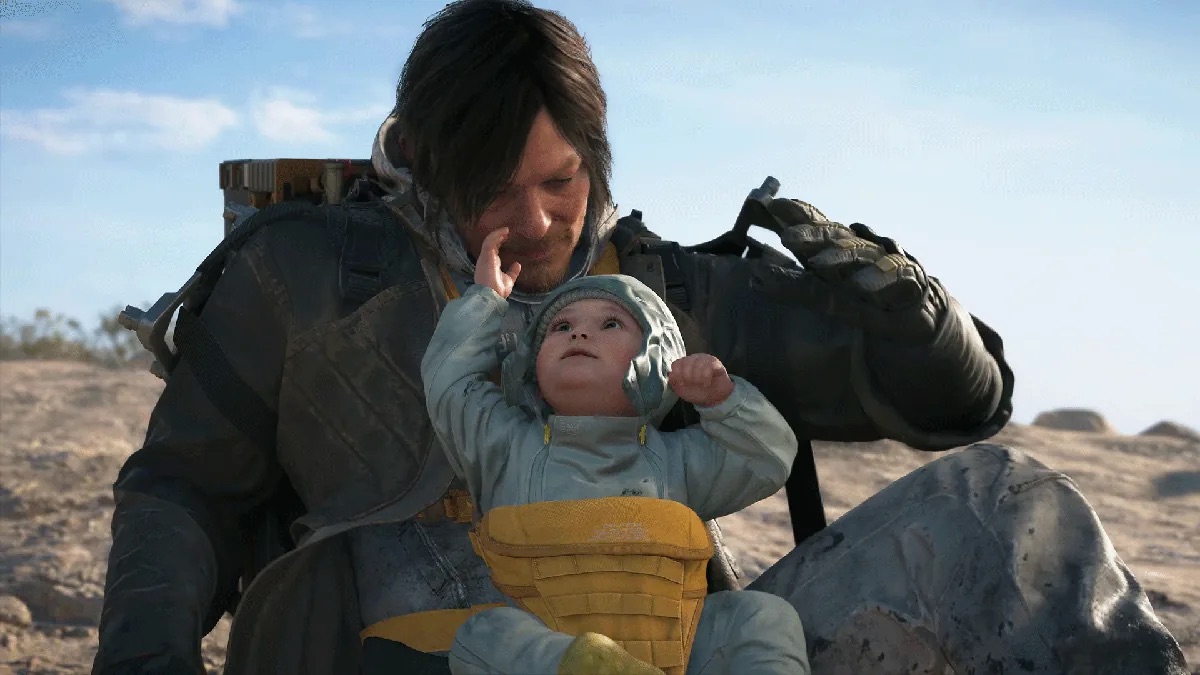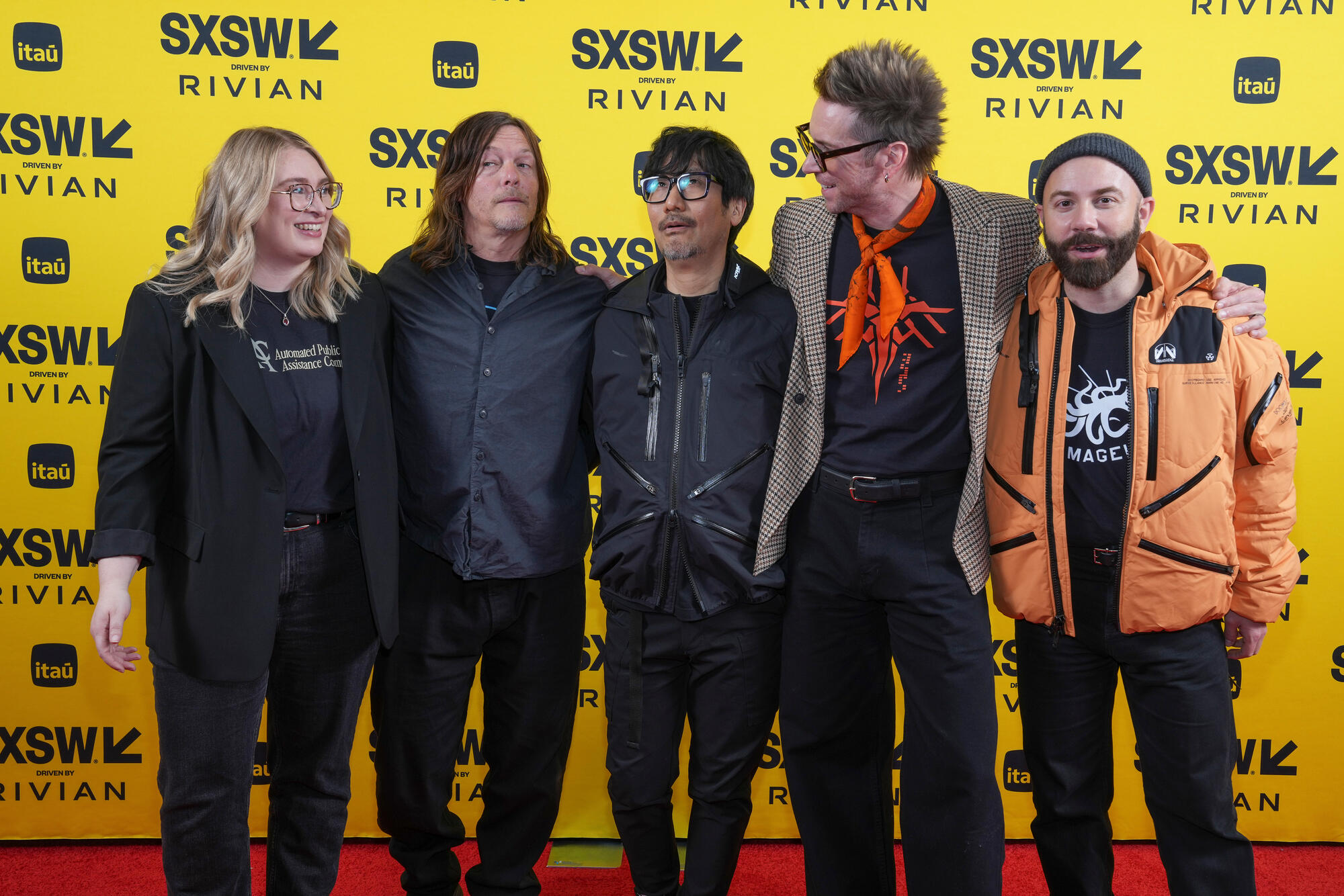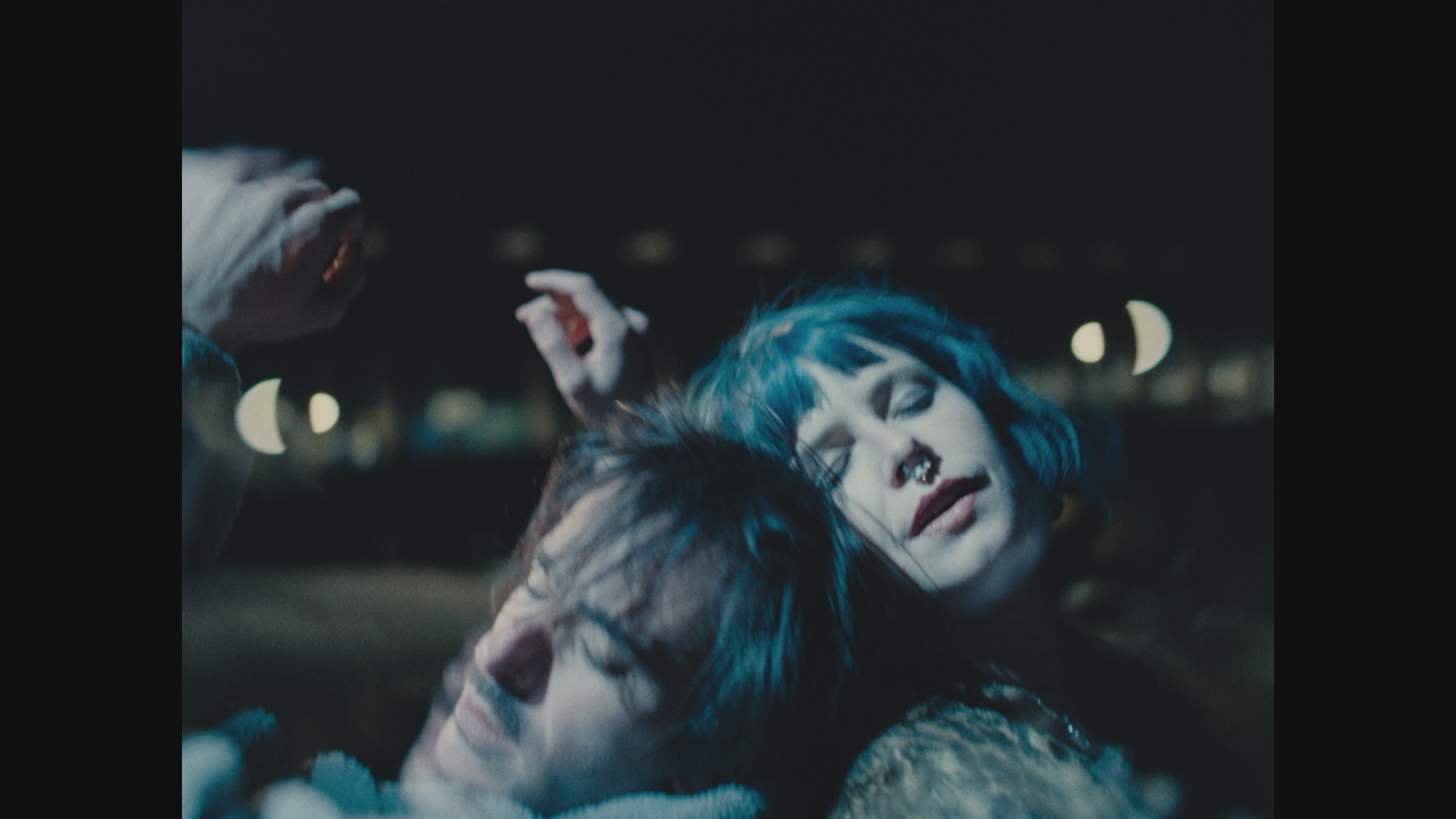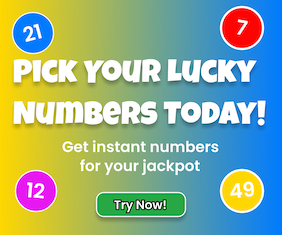The chance to speak with Hideo Kojima is not totally unlike meeting a world leader. Alternately — extending this metaphor another way — talking to him while activity at Kojima Productions buzzes in the background over a video interview suggests having a peek inside a spy agency.
The video game auteur, whose Tokyo studio is visited by everybody from Conan O’Brien to Timothée Chalamet, has just released “Death Stranding 2: On the Beach,” the sequel to 2019’s “Death Stranding” and his second consecutive work that does more to break from the medium’s confines than anything I could name. “On the Beach” is an especially bold step towards the cinematic, with a cast (Norman Reedus, Léa Seydoux, George Miller, Guillermo del Toro, Luca Marinelli, Nicolas Winding Refn, Elle Fanning, and Fatih Akin) far closer to a major festival lineup than animated characters in a video game.
Even if IndieWire’s own David Ehrlich hadn’t claimed “Death Stranding 2” was a “mega-bizarre masterpiece,” Kojima is a figure who deserves time and attention. Speaking as someone who’d write out the absurdly convoluted “Metal Gear Solid” chronology while bored in middle-school math, the opportunity was not to be taken lightly. When I called into Kojima Productions last week, the director was taking a break from his next projects: “OD,” a horror game co-written with Jordan Peele and starring Hunter Schafer, Sophia Lillis, and Udo Kier; and “Physint,” a stealth action game that has already kicked up rumors of a lead role for Robert Pattinson. Questions about those were — surprise — immediately deflected, but “Death Stranding 2” offered sufficient fodder for discussion.
This interview has been edited for clarity and length.
Indiewire: It’s Tuesday in Tokyo, and “Death Stranding 2” has been out for exactly a month. What are you working on today?
Hideo Kojima: Well, I’m checking the data of the players all over the world — what kind of weapons they’re using, the routes they’re taking, all this data. And I also see these small bugs here and there, so I’m deciding where to fix and what to fix. I also am starting to work with the team on “OD” because that’s a new project, and also doing “Physint” all by myself because that’s at the conceptual stage. So I’m doing that. And also I have all these interviews every day, and also promotional — photo-shootings, things like that — so I don’t feel like I’ve finished the title, to be frank.
No work of art is ever truly flawless or perfect. I wonder how you feel about having this after-the-fact ability to improve your own work. That’s a unique opportunity compared with filmmakers who can’t necessarily go back to fix flaws in their films. Do you feel a game ever is emboldened because of its flaws?
There are some things that you shouldn’t change. Like the story, for example, because there is a certain era that that story was born. You shouldn’t change those kinds of parts. Or, you know, like [George] Lucas changed [‘Star Wars’] to all CG, but that’s because it’s a new era, right? So I don’t want to change anything that would affect the era that it first came out. The things that I said that I’m changing are, you know, all the things basically related to gameplay. Like: This item was not very easy to use, so I’ll make it a little bit more accessible, or, like, make the UI bigger. These small parts are the ones that I’m changing. I know that DLC [downloadable content] is not a trendy space because if you start doing that, you’ll never finish the project.

“Death Stranding 2” is maybe your most confidently directed work, and I’m fascinated by how your style has reached a kind of minimalism since the later “Metal Gear Solid” games. The cutscenes tend to be shorter, the shots longer, the visual style more fluid.
“DS1,” there were a lot of long cutscenes, yes, because it was supposed to start slow, right, and to explain everything — it was slow — but I see a lot of people discontinuing watching the cutscenes from “DS1” by stats. Because, for me, cutscenes are part of the game. Some people don’t even think about that, but I believe cutscenes are part of the game. So what I do is: I have these bunches of cutscenes, games, and events, and I lay them out and really change through the play-through — like, I change the length of the cutscene if the cutscene, I feel, is too long. The rhythm is very important. I check the rhythm of the game, and I kind of change everything. So maybe, you know, that’s one reason. I even change it after taking the motion after sessions with the actors, and I kind of adjust the balance of that rhythm, as I said, and I think it’s becoming better because of that.
What tech advancements affected your directorial style in recent years — is it the reliability of A-list acting talent, smaller cameras that allow for more movement and set-ups, or something else altogether?
During the pandemic, we held performance-capture sessions at the Sony studio in L.A. We had the actors arrive on set in L.A, but our staff was restricted from traveling abroad. I had to direct from Tokyo. Those were the rules by Sony at the time. Reluctantly, I was forced to direct from afar. We used smartphones, Zoom, iPads, and multiple cameras for the remote session. I protested and said it was impossible, but I was told that all other studios were also doing it remotely and that I would need to follow the same rules. To test out the remote session, we tried out two scenes that didn’t require the main characters. The results were quite disastrous. I couldn’t grasp the spatial dynamics of the set, like the positioning of the virtual cameras, the actors’ movements, and directing their performance; it felt hopeless. I thought I wouldn’t be able to shoot.
That’s when I reached out to the development team about a system called “Mado” [“Window” in English] at Sony headquarters. I borrowed two of them and set them up — one in Tokyo, the other in L.A. It’s like a giant smartphone the size of a door. The two were synced and allowed for two-way communication of both footage and sound. On the other side of the screen, we could see life-sized actors. Though it was through a screen, we were able to communicate with each other as if we were standing outside each other’s window. We were able to overcome that period by fully utilizing that technology.
Can you talk a bit about what that remote work looked like, and how you feel your direction benefits from being in person with your actors?
Well, even though I have, like, 20 cameras on this side and that side as well, it was really difficult to describe the stage and the set in its direction. Like, for instance, me directly saying, “OK, you act from here to there. You walk from here to there.” It’s impossible to just say “here to there.” They won’t know where from where. For instance, if I were talking to the actor on the spot in the scene — like Norman [Reedus] — I had to say, “Hey, Norman, you walk from here all the way up to Léa and you say this line,” and things like that, it’s so difficult to explain that if you’re not there. Although I could see, because we set up so many cameras, it’s so difficult to explain the position physically at just one point. [Laughs] I couldn’t wrap it up as though I was in the scene — I was just through the camera, and that was so difficult.
You talked about how the quality of an actor’s facial scan between “Death Stranding” and “On the Beach” improved significantly — specifically how Léa Seydoux’s face is now more lifelike, more vivid. Did seeing stronger face work engender anything in a rewriting process? If you watch these scenes and understand you can actually gather more emotion from Léa or Elle Fanning or Norman Reedus, than you had understood while you were initially writing a scene.
Yes, I do that a lot. I even did during shooting as well. Like, for instance, Léa’s smoking scene — that was not initially in it, and I had it added. [Laughs] As you know, we’ve been working with 3Lateral, and the rigs of the facial have really upgraded, and we could do a lot of facial expressions — very subtle ones as well — so I kind of even changed the scenes where I take out some lines because facial expressions could be covered, and I kind of make that decision on the spot. Even the lighting: I kind of asked a lighting technician, a professional lighting technician, to come to teach the staff about lighting in general, so we took, like, a healthy two years to learn all of this about all of this — about all the lights and things like that. So that could have an influence, too. [Laughs]
You’ve often talked about blurring boundaries between cinema and video games. What is the greatest struggle in doing so? Outside the obvious matter of interactivity, where are the media most incompatible?
In film, the creator controls the timeline. They can choose exactly what images to show, what performances to present, and what sounds to let the audience hear. Everything is delivered the way the creator wants. But with games, that’s not possible except in cutscenes. The creator has no control over the timeline — the player decides everything. Sometimes, players might even skip important scenes. The creator has no say in that. That’s where games differ from films. And from theater, too — in theater, you’re free to look wherever you want, but the timeline remains controlled. In games, you can view the stage from any angle and even walk away midway. In other words, creators can’t calculate or plan everything because it all depends on the player’s actions. Films are about showing a series of carefully curated images, but you can’t approach games with the same mindset. I think that’s where it creates a sense of uncertainty for both the performers and the director.
There’s also the issue of recording time. Unlike films, where you can concentrate on the shoot over a period of three to six months, that kind of intensive schedule is difficult for games. Game development involves filming little by little as you go — maybe like a week each month, sometimes with long gaps in between. For “DS2,” the entire process took about three years. That makes it a very challenging environment for the actors. Scheduling is difficult, too. Sometimes there’s been a long gap since the last session, and the actor must recall the emotional tone from the previous performance.
“On the Beach” continues the narrative arcs and themes of “Death Stranding” very fluidly. That’s surprising because you’ve been very honest that a lot of the game was rewritten amid COVID-19. But you’ve never revealed the original plot. Now that we’re some time away from “Death Stranding 2” and people like myself have actually been able to play it, are you at any liberty or desire or comfort to say how the original version of the game would have differed?
[Laughs] Well, I found the initial concept sheet, actually. I have to say a big theme of “DS2,” or the direction, hasn’t really changed, but the story — or the ending — has changed after the pandemic, yes. The first half seems quite similar to the original one, but from the middle point onwards, I kind of rewrote a lot. You know, all these lines that were newly created are actually spoken by the President [Alastair Duncan] at the end — or what Die-Hardman [Tommie Earl Jenkins] says at the end. This is what I was thinking during the pandemic, and I put that in there. So that’s a big change.

Do you expressly prefer keeping something like a concept sheet tucked away and letting the game exist as it does? One of your favorite films is “Blade Runner,” and part of its mythology is the question of whether or not Deckard is a replicant, right? But that’s something that only came about because Ridley Scott, decades later, would admit it. I wonder if you have a similar interest in sharing alternate versions of your work.
[Laughs] No, I don’t feel like I should say those things. I have my conclusion. I have my, you know, things that I thought about, but if I confess that, it won’t probably be art anymore. For instance, if I drew a drawing of an apple and I put that in a museum and I say “this is an apple,” but all the people who saw it, it doesn’t matter if they think it’s an apple or a banana. But if I say, “No, no, no, what are you saying? I drew an apple,” I shouldn’t say that. Well, Ridley Scott is an exception. He’s a Sir, right? He could say whatever he wants.
Is there something that you look for or see in an actor, in a live-action context, that tells you they could convincingly deliver a motion-capture performance? If it’s something in their face, their voice, their body language. Because I think you might be the only person who’s ever watched Luca Marinelli and said, “He should be in a video game.” Or is it as simple as one form of acting translating to another?
Well, I don’t really regard them as being “in the game.” I just look for actors who are good — like, they’re good in terms of the looks or the emotion, their expression, their acting. And when I think of a character in my game, I think of, “OK, who should I cast?” And those people come up. At the same time, we take one step of changing them to CG, so they have to really be individualistic. You see what I mean? We take one cushion, as a CG, until we put them in their performance. Then what I do is: I talk to them directly. And if it matches, I talk to their agents. So I think it’s the same as, you know, casting in the movies. Every time I talk with Guillermo del Toro or Nicholas Winding Refn, we always talk about, “Oh, who’s coming? Oh, did you see that movie? Did you see his acting? Did you see her acting?” It’s kind of the same with even these movie directors. So I regard myself as no different than how I cast in other people as well.
Are there any deceased actors who you think might have fit your worlds and sensibility?
That would be my childhood hero, Steve McQueen. If it were possible, even with CG, I would love for him to be in one of my games someday. In my games, I’ve featured film directors whom I know personally or greatly respect. In fact, I had always hoped to cast David Lynch, a director I’ve admired for so long. However, he passed away not long ago, and I’m devastated.
Some have compared your games to the work of Thomas Pynchon, who even went so far as to mention you in “Bleeding Edge.” Are you familiar with Pynchon’s work, and has it served as any kind of influence on you as a writer?
Yes, I know Thomas Pynchon and read, and acknowledge that I was in one of his writings. Yes. But I don’t really get the point where I’m “influenced”; I don’t really think about it, actually.
Well, that answers the question. Thanks for taking time from your busy schedule; it’s very appreciated.
Also, I want to add that I do admire Thomas Pynchon as well. [Laughs] I like his writing, so don’t, you know… don’t get confused about that. Don’t say that I’m not influenced by him or anything like that! Because I do admire him.
“Death Stranding 2: On the Beach” is now available on PlayStation 5.



